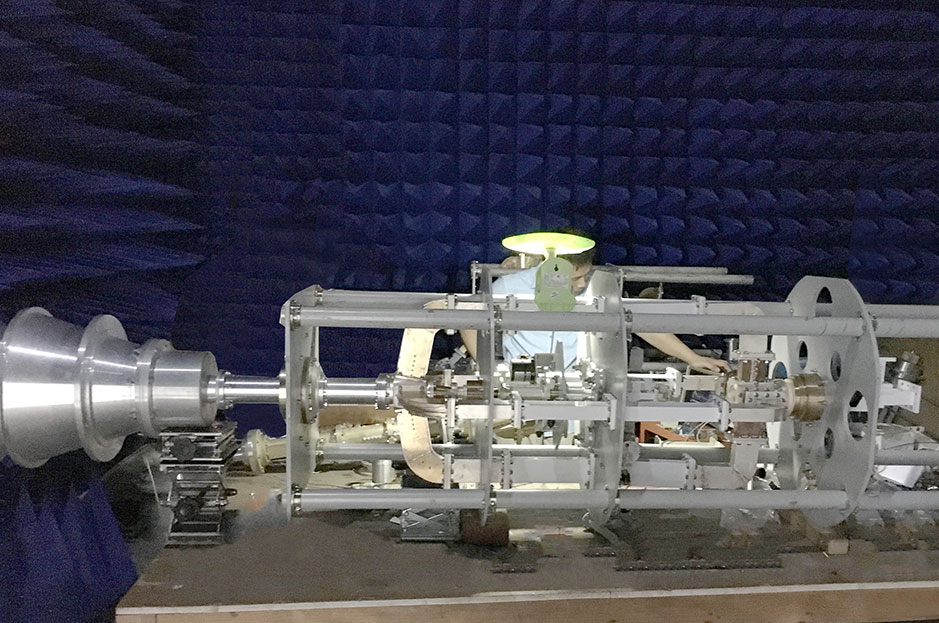Antenna feeds and RF networks as the heart of antenna system from Dolph Microwave is R&D by experienced our engineers who engaged into satcom and RF field for years. The components can be offered including OMT, duplixer, filter, phase shifter and feedhorn etc. covering different bands like C-band, Ku-band, Ka-band, S-band. X-band and required dual band etc. Any requirement, please contact sales@dolphmicrowave.com
For an antenna feeds design, the efficiency, gain, and absolute gain are very important.
The feed impedance includes the loss resistance and the radiation resistance. The loss resistance is offered by the antenna components and the feed impedance is at the input of the antenna to the signal. Thus, the loss and the feed impedance must work together to achieve antennae feed normally work.
The radiation resistance is offered by the antenna to the radiation power namely the dissipated radiation power.
The feed point impedance of an antenna is a crucial parameter that reflects its input impedance at the feeding point. Several methods exist for measuring this impedance, including:
Standing Wave Method: This method utilizes a standing wave meter to measure the standing wave ratio (SWR) on the antenna. Then, based on the SWR, the feed point impedance can be calculated. While simple and readily available, this method offers limited accuracy and is best suited for antennas with subtle impedance variations.
Short Circuit Method: A short-circuit ring is placed near the antenna's feed point, and the input impedance is measured. This method offers good accuracy but requires placing the ring close to the feed point, which might affect the antenna's radiation characteristics.
Open Circuit Method: Similar to the short circuit method, but an open-circuit termination is used instead. This method also offers good accuracy but suffers from potential impacts on the antenna's radiation due to the open termination close to the feed point.
Vector Network Analyzer (VNA): Utilizing a VNA provides the most accurate measurements but comes with a significantly higher cost and requires more complex operation.
The choice of method depends on factors like antenna type, required accuracy, and cost considerations.
Here are some key points to remember when measuring antenna feeds point impedance:
Measurement environment: Minimize electromagnetic interference in the surrounding area.
Measurement equipment: Ensure the equipment's accuracy meets your requirements.
Measurement method: Follow the chosen method's procedures meticulously.
Here are general steps for measuring antenna feeds point impedance:
Mount the antenna appropriately.
Connect the measurement instrument to the feed point.
Set measurement parameters.
Conduct the measurement.
Record the results.
The feed point impedance of an antenna significantly impacts its various performance aspects:
Standing Waves: Mismatch between the feed point impedance and the feedline's characteristic impedance leads to standing waves on the antenna. Higher standing waves translate to lower power transfer efficiency and increased losses.
Bandwidth: Feed point impedance influences antenna bandwidth. Impedance matching maximizes bandwidth potential.
Gain: Similarly, gain is also affected by feed point impedance. Matching optimizes the antenna's gain.
Efficiency: Again, efficient power transfer requires impedance matching, leading to maximized antenna efficiency.
Radiation Pattern: Mismatch impacts the radiation pattern, potentially causing deviations from symmetry.
To elaborate:
High or low feed point impedance compared to the feedline's characteristic impedance increases standing waves, reducing efficiency and gain.
The real part of the feed point impedance affects bandwidth, with higher values leading to narrower bandwidths.
The imaginary part affects the resonant frequency, with higher values causing lower resonance frequencies.
Therefore, careful consideration of feed point impedance is crucial during antenna design to ensure optimal performance. Choosing appropriate feeding methods for impedance matching is essential.
Techniques for Improving Feed Point Impedance Matching:
Matching networks: Introduce matching networks to adjust the feed point impedance to match the feedline's characteristic impedance.
Structural adjustments: Modifying the antenna's structure can alter its feed point impedance.
Feedline transformers: Utilize feedline transformers to change the feedline's characteristic impedance.
By implementing these techniques, you can enhance antenna performance and ensure efficient operation.
A feed horn is used to couple a waveguide which is used in radar, line-of-sight microwave transmission or radio astronomy. The feed horn minimizes the mismatch loss between the antenna and the waveguide. When the feed horn is used for a offset, parabolic or lens antenna, it is placed at the focal point of the reflector. The features of the feed horn is usually selected with the 3 dB points of the horn's radiation pattern falling on the edge of the reflector. When the shape of the antenna deviates from a dish, the feedhorn needs to be shaped accordingly to illuminate the antenna properly.


Antenna feed normally includes the components like OMT, phase shifter, rotary joint, feed horn, filter namely diplexer as well as bend waveguide etc, which is based on customer selection based on system application.
A Diplexer is a 3-port passive device that allows two different devices to share a common communication channel. It consists of two filters (Low Pass, High Pass or Band Pass) at different frequencies connected to a single antenna. Both the signals input to filter 1 and filter 2 need to be at different frequencies by a significant percentage, so that filters can easily sort them.
A Duplexer is a 3-port device that allows the transmitter and receiver to use a single antenna, while operating at the same/similar frequencies. It is a device that allows two-way communication over a single channel by isolating the receiver from transmitter while transmitting a pulse and isolating the transmitter from receiver while receiving a pulse, allowing them to share the same antenna. In a duplexer there is no direct path between the transmitter and receiver. It can be thought of as a circulator.
Phase Shifters are a critical component in many RF and Microwave systems. Applications include controlling the relative phase of each element in a phase array antenna in a RADAR or steerable communications link and in cancelation loops used in high linearity amplifiers.